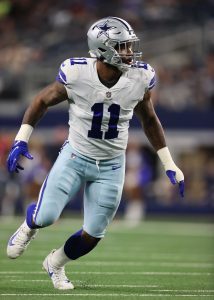This week brings the annual deadline for teams to exercise or decline fifth-year options, with the 2021 first-round class in the crosshairs this year. That group marks the fourth crop of first-rounders to have their fifth seasons evaluated with fully guaranteed money in play, but the fifth-year option has existed since the 2011 CBA.
With first-round contracts becoming increasingly burdensome as the 2000s progressed, 2011’s lockout-marred offseason produced a rookie pay scale that remains in place today. The slot system also ended teams’ ability to sign first-round picks to six-year contracts, as Sam Bradford, Trent Williams and a few others from the 2010 draft received (while attached to deals that dwarfed some impact veterans’ accords).
 As owners removed lavish rookie contracts from the game, they gave up a year of control. Draft-slot contracts have spanned four years since the July 2011 agreement, but the fifth-year option — available on first-rounders’ rookie deals — became a way for teams to retain their top picks without extension costs entering the picture.
As owners removed lavish rookie contracts from the game, they gave up a year of control. Draft-slot contracts have spanned four years since the July 2011 agreement, but the fifth-year option — available on first-rounders’ rookie deals — became a way for teams to retain their top picks without extension costs entering the picture.
A loophole existed that further benefited teams during the 2011 CBA’s version of the fifth-year option. As second- through seventh-round draftees could hit free agency following their fourth seasons — making teams more likely to negotiate ahead of Year 4 — first-rounders both could be tied to a fifth season and then see their team bail on the option free of charge by March of Year 5.
The 2011 CBA guaranteed the options for injury only, meaning a team could move on from a player with no dead money if the player passed a physical at the start of the league year. This allowed teams to put off negotiations for extension-eligible players into Year 5 and also gave clubs the freedom, provided the player was healthy, to escape a first-rounder’s rookie contract before the money became guaranteed when the league year began.
This happened on a few occasions, with Robert Griffin III being the most memorable example. Washington picked up RG3’s fifth-year option in 2015 but cut him, after bubble-wrapping the former No. 2 overall pick behind Kirk Cousins, in March 2016. The 2020 CBA addressed this issue. When teams exercise a player’s option now, his fifth season is fully guaranteed.
The 2020 CBA also changed the structure of the fifth-year option. Exercising an option from 2014-20 meant players drafted from Nos. 1-10 were tied to the value of their position’s transition tag. For players chosen from Nos. 11-32, the option came out to the average of the third-25th-highest salaries at their position. With the 2020 CBA fully guaranteeing the options, it also introduced a performance- and participation-based system that divided each position’s option prices into four tiers.
Players selected to two or more Pro Bowls (original ballot only) in their first three seasons reside on the top tier, which matches the franchise tag value. Micah Parsons, Patrick Surtain and Ja’Marr Chase checked in on that tier this year. Tier 2 covers first-rounders who earned one original-ballot Pro Bowl invite over their first three seasons; this level matches the transition tag number. Rashawn Slater and Kyle Pitts‘ option prices came in here. Participation covers the final two tiers. Players who achieve any of the following will receive the average of the third-20th-highest salaries at their position:
- Players who averaged at least a 75% snap share through three seasons
- Those who logged at least a 75% snap share in two of their first three seasons
- Those who crossed the 50% snap barrier in each of their first three seasons
Tier 4 covers players who did not meet these participation standards; those players’ options come out to the average of the third-25th-highest salaries at the position. Teams have until May 2 to exercise or decline options. With the 2020 CBA not set to expire until March 2031, this option format stands to be in place for a while.
Note: This is a PFR Glossary entry. Our glossary posts explain specific rules relating to free agency, trades, or other aspects of the NFL’s Collective Bargaining Agreement. This post was modified from an earlier entry by Zach Links.
